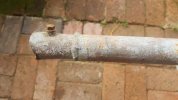Sand bending can be an artform...
when I was young I got to watch an old Italian guy, John (Gianni) Derietta hand sand bend some extractor pipework for an open wheeler race car, a bag of curling snakes, each made as one piece (not cut and sectioned) with mutliple compound bends in all directions...
I only spent a few hours wacthing, but he'd fill the tube with dry sand... use an arbor press to really compact the sand, braze end caps onto the pipe (like a core plug cap) and then he would heat sections with a large propane torch, and clamp then bend around various daiameters of large pipes (like 12 / 16 inch diameter) set standing up .... the material would form perfect curves, but very slowly.
when he was done he just cut the bent section of tube where he wanted, the sand ran out, and there was one of the extractor tubes perfectly copied, by hand and by eye.... he was an older guy in his 50's (this was 40 years ago) so I doubt he's still around.
@lidox19 I didn't have a 3m long chest freezer either, I did 800 or 900mm lengths standing up, to build a turbo exhaust system in 3" for a rally car ... it was just to show that there are alternatives to a solid mandrel

there's a join just inside the tunnel section, not saying they use a different tube size from there forwards, but they dont make them as one piece... and 35mm OD will be a very tight fit to get your hoses on , try it , so they kinda have to neck them down at the very ends at least before swaging in the lip. I've had to work on a few X19's that have had the pipes replaced, and there are times getting hoses on can be a chore, and I've seen plenty of cut and nicked hoses caused by the replacement pipework
an exhaust place with a good tube bender, they will have a fitting to re size the OD of the pipe down a fraction. Like an internal conical affair that you push over the end and lets you size the OD of pipe down to become ID, sized so it fits inside it's original ID
SteveC


